Uncle Alf
A Desert Tanker
1/35th scale model from Wee Friends
Article in Military Modelling Magazine in 2007
I think most of my generation can name someone from their family, either parents or grandparents who took part in World War II.
The painting of this model was partly inspired by an old photograph that my wife has, of her family; one of the relatives pictured took part in both World Wars, the photo also showing one of his sons who fought in the second war.
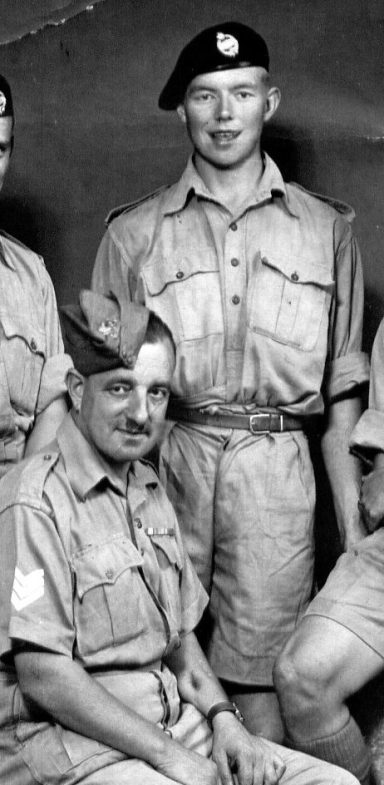
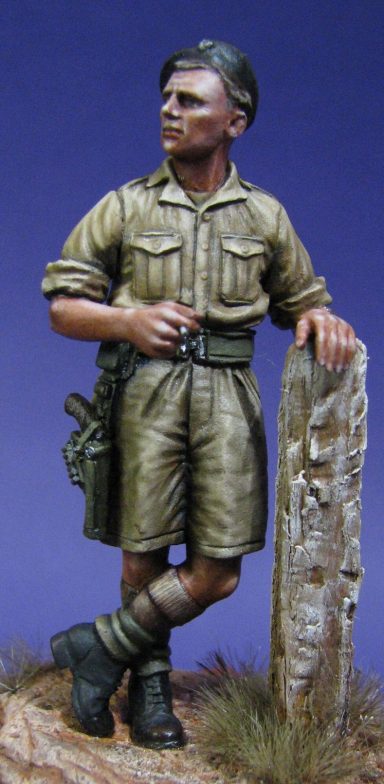

The picture here is of them and two friends, the chap in the centre at the back being my wife’s Uncle Alf, the seated fellow at the front being her Grandfather, William Smith.
Alf was seventeen at this point, having lied about his age to get into the forces, although he did find help from a fellow called John Toolmin, who “looked out for him”. Alf was part of the initial expeditionary force that went to France to defend against the German invasion; His tank was destroyed close to the beaches of Normandy, and he waited in the water for three days as enemy planes strafed the lines of soldiers waiting to be taken to safety by the flotillas of boats; bravely manned by men willing to risk those same shells and bullets.
His war wasn’t over though, he returned to fight in the desert against Rommel’s forces, and remained uninjured until the end of the war. After demobbing, he returned to the army and served in West Germany for a further twenty-one Years.
William Smith ( Alf’s Father ) was a veteran of the First World War, having received wounds from being shot through the arm ( the scar - a hole through his left forearm - visible in this picture ). The bullet passed straight through his arm, shattering his pipe lighter, which whilst it probably saved his life, gave him several severe wounds to the upper chest.
He also served in World War II, and was present at the battle of Tobruk where he was temporarily blinded during the fighting. A regimental musician, he played the cornet, although he did duties as a stretcher-bearer during combat. One of his daughters remembers asking “Why’s he got to be a stretcher bearer Mum ?” The answer she got was “Well he can hardly be playing the cornet on the battlefield, can he ?”
William was discharged before the war’s end because of his failing health, and he died in 1945 because of kidney failure.
The weak kidneys were to burden the rest of his family – of the eight children he had, three were given kidney transplants, the account above coming from his last surviving daughter, Sheila Lynch, before she too died in November 2007.
The model.
When I got this model, I just knew I’d end up painting it, it’s sculptor – Pete Morton – being a rather talented chap, who always seems to turn out nice stuff in small scale.
This is a true 1/35th scale figure though, and looked decidedly petite next to the 54mm giants I’m used to throwing paint at. It’s aimed at the AFV guys really, as something to give scale and comparison to a vehicle.



Photo #1 shows the parts and photo #2 a close up of the painted sample that is pictured with them. The parts are cleanly cast, and only need a light touch with a file or a scalpel to remove part lines from the sides of the castings. The metal is very brittle though, and in my haste, I snapped the little pouch that is at the top of the holster sling.
That didn’t slow me down much, Magic-sculpt was used to build a new one – look ten minutes scrabbling about on the floor is enough for me to give up hope of finding a part. It’s Sod’s Law though that the part will turn up in the Hoover about half an hour after finishing the figure ( which it did ) although no amount of vacuum use will find it before painting is finished.
Sod that, it’s nice enough to paint on it’s own !
Originally from the Jakrai range, it’s now being marketed by Friendship Models under the “Wee Friends” banner, along with several other nicely sculpted WWII figures Sculpted by Pete.
So, having been inspired by family history and the fact that I’d got a very nice little figure in desert campaign dress, I thought I’d have a go at painting it. Granted, I had a bit of a timescale problem – I was off on holiday within the next week, and wanted to have the figure painted before leaving.
Not too tall an order – he was only 48mm high !
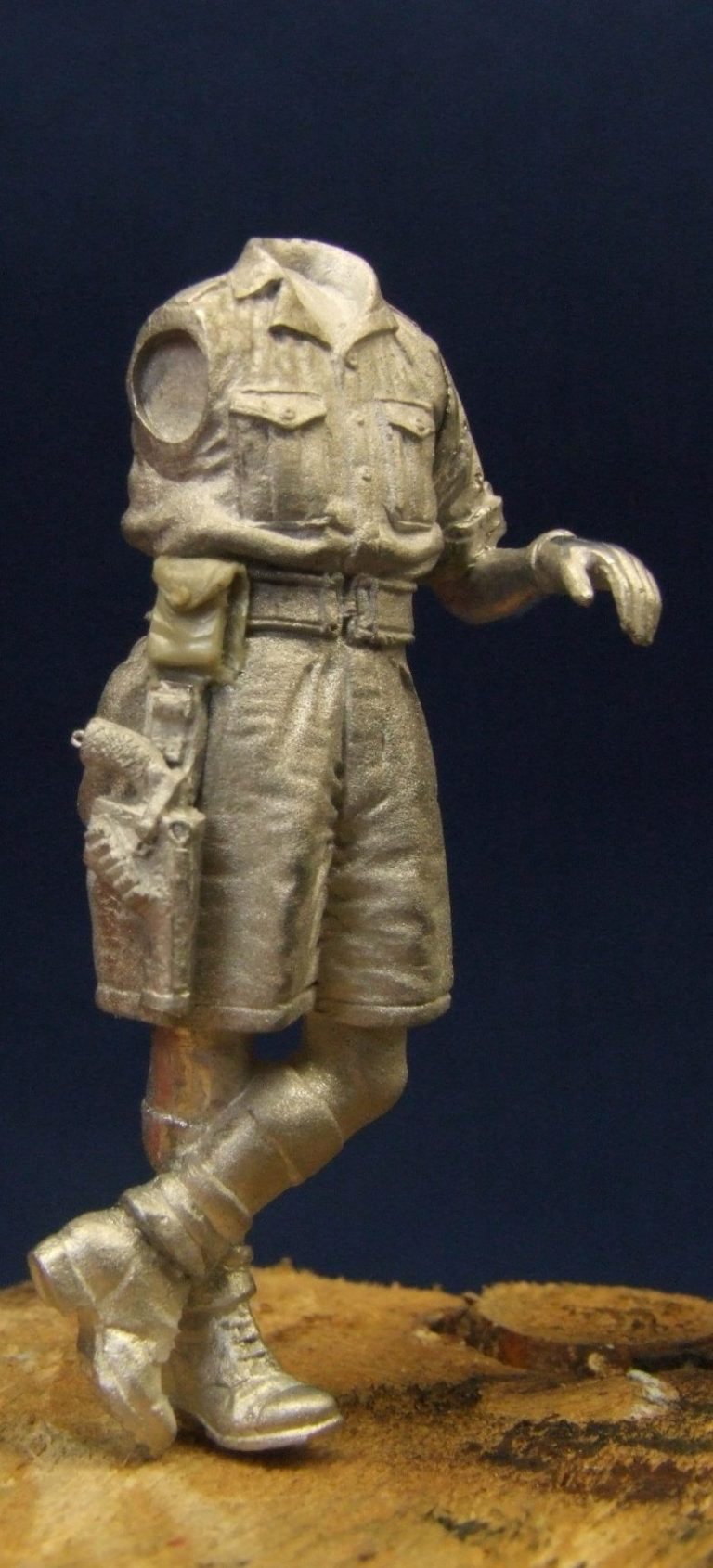

Colours used – all Winsor and Newton -- a sun-bronzed mid-tone being made up from Flesh Tint, a little Mars Yellow and some Mars Brown. This was shaded with more of the Mars Brown and highlighted with Titanium White. Further deep shadows would be added once the parts were all fastened together, and for them I used Burnt Umber, thinned with White Spirit.
Also in this shot can be seen the build up of highlights to show where the muscles and bones stretch the skin thinner – the muscle at the side of the elbow as the arm is raised; the point of the elbow, the two points of the wrist and the knuckles where the skin is again pulled taut over the bones.
So, putty pushed into shape, hardened under a lamp, and I was ready to prime the figure. I used Humbrol Flesh acrylic as the primer, diluting a small amount of this with Isopropyl Alcohol for the initial coat, then using the paint thinned with water for a further three layers of paint to allow the colour to build up smoothly. This was employed as a basis for the skin colour that would be added in the usual oils.
Photo #3 shows the bare metal casting with the left arm fastened in place and photo #4 shows the arm with painting completed.
You can see here the acrylic flesh tone on the shirtsleeve, and the shine on the wet oil paint on the arm.
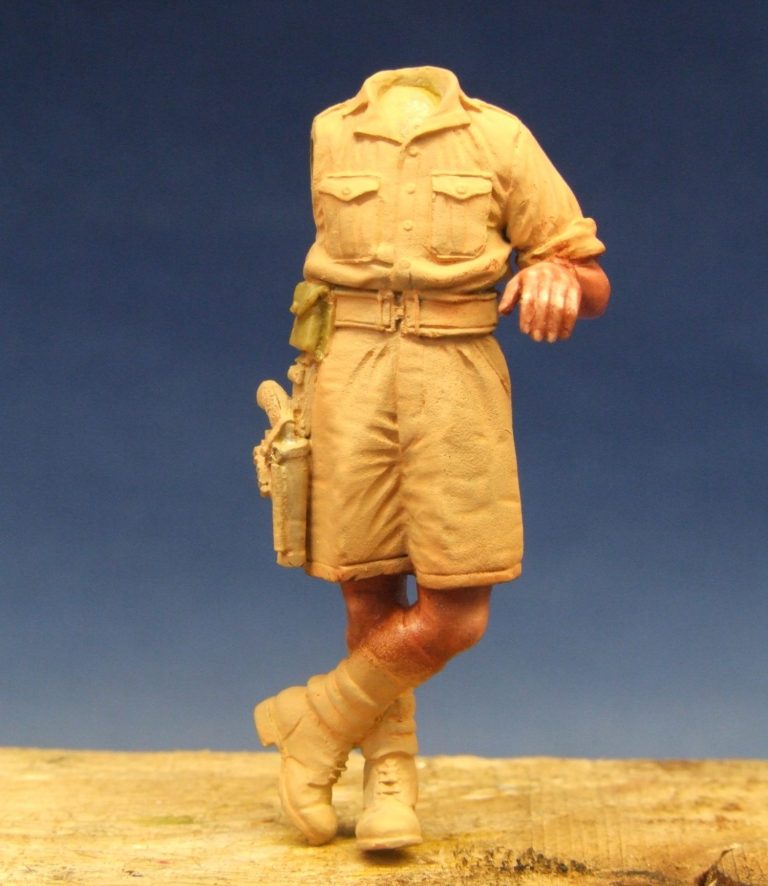
Photo #5 shows similar attention lavished on the main casting and the left arm. This arm was attached, because it’s position away from the body doesn’t foul the brush from getting to anything else – as opposed to the right arm, which could cause problems with getting to the shirt easily. Note the fingernails in this shot too – paint a little of the shadow onto each of the fingertips, closely followed by some of the lightest highlight. The merest touch is necessary, but with a little practice convincing nails can be painted in, even if the detail isn’t sculpted ( hey, this guy’s tiny ! ). Strangely, it’s little details like this, which most folk deny being able to see without magnification, which make the piece “look right”.
The next shot – photo #6 – shows the head. The lighting and paint that is still wet have conspired to cause the furrowed brow to be completely lost, but later shots show it’s there. I have to be honest and say that at this scale, the eyes are pretty basic – whites painted in with a small amount of the highlight flesh tone, and then a very dark brown made up of Mars Black and Mars Brown to denote the pupil. I’ve tried to add very small catchlights to the eyes, but to be honest, they really are too small to make out, even at this magnification – completely pointless exercise, apart from teaching me to hold my breath and really tense / relax my grip on the paintbrush for a good ten seconds……..


Now, photo #7. Here’s where it gets interesting.
Pete has done a really good job of the sculpting; those trousers look lived in with all the tiny little creases. I wanted to bring that out, albeit subtly, and again opted for oil paints to do the trick.
Photo #7 shows how I began, the far leg of the shorts being painted with a mix of Mars Brown and Mars Yellow ( a denser version of Yellow Ochre ). This is O.K. for a greenish tone of Khaki, but I wanted it to look a little warmer, so added some Burnt Umber and Mars Brown, both of which have a red bias, and thus warm up the colour from it’s colder green hue.
Ratios – sorry guys, just played about with it until it was what I wanted. The yellow to black mix was probably 4:1, but the browns were added in small amounts to just tint the colour slowly, so I couldn’t honestly tell you how much there was.
That was the main colour, with just a small amount of Titanium white added for highlights, and more of the Black ( but not much of this latter colour ) added for the shadows.

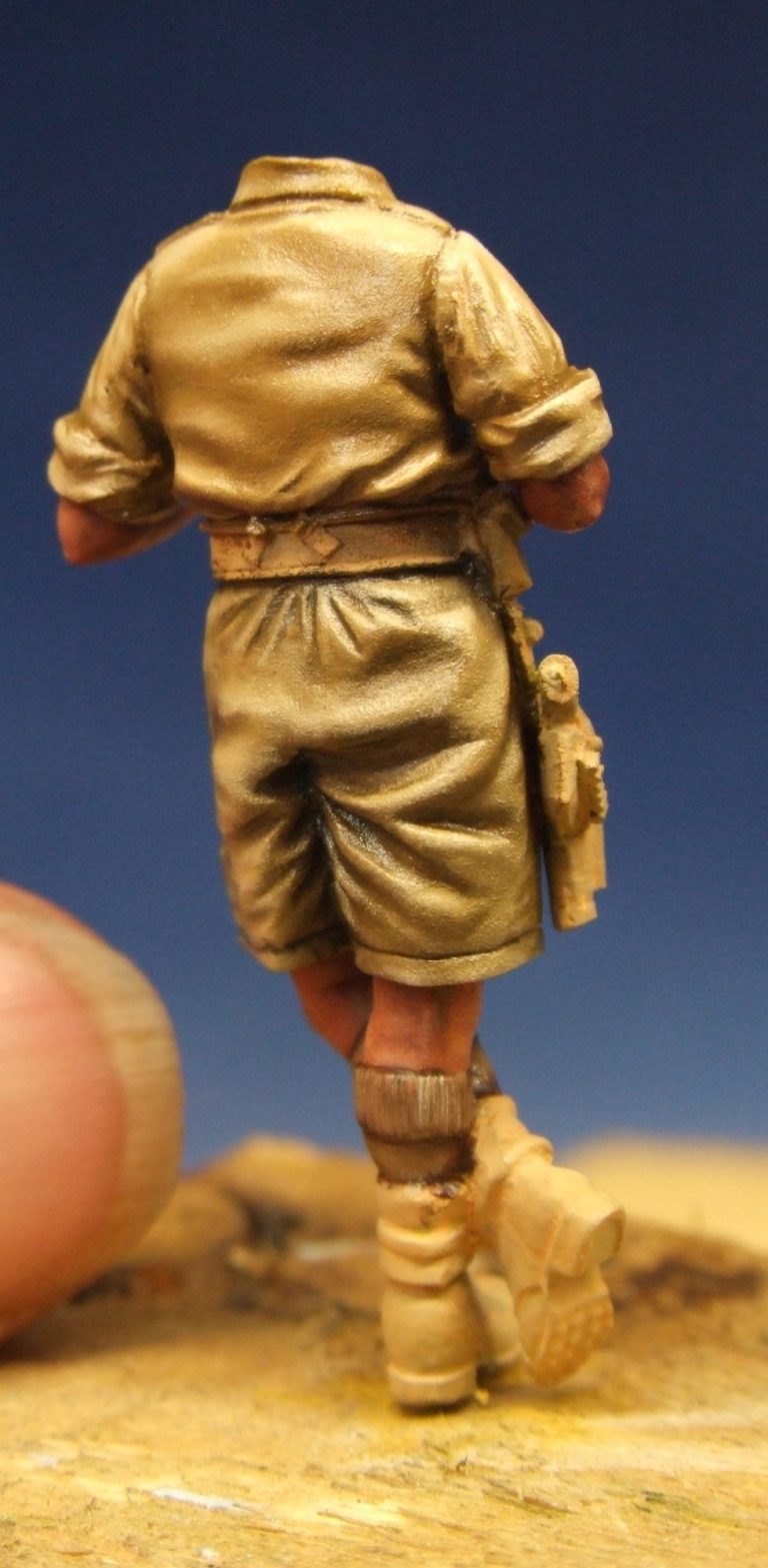

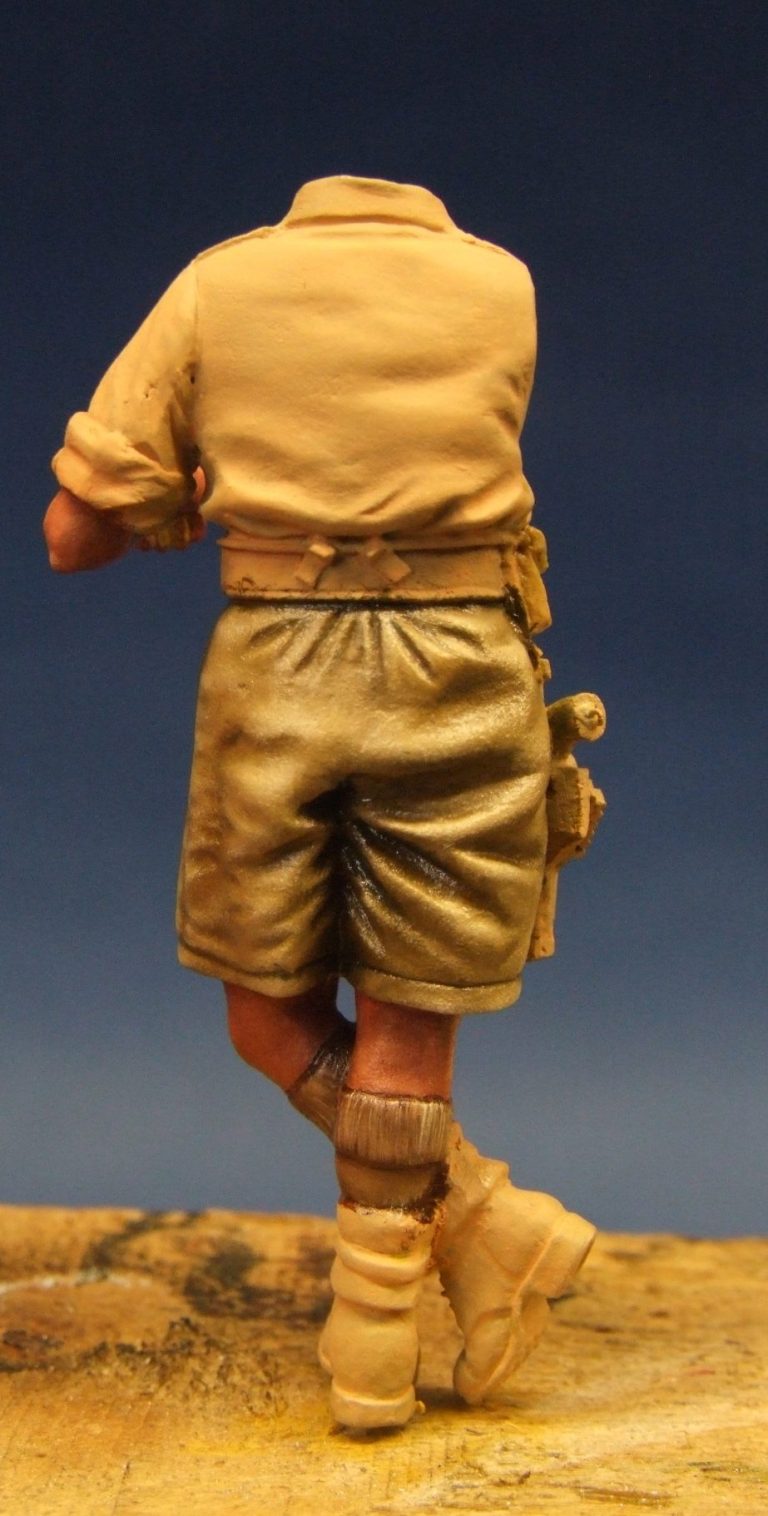
I worked around the figure painting the shorts first – see photos #8 and #9, then added more of the Mars Yellow and Mars Brown to the base mix to give a lighter and warmer colour for the shirt, as can be seen in photos #10 and #11.
This first of these two shots looks very shiny, again apologies, as the paint was wet when this was taken. The second picture shows my thumb too. No, it didn’t just get in the way; it’s there to allow you to judge the size of the figure.
Photos #12 through to #16 show how the figure finished up – the pistol and holster painted in, along with the belt and the cap badge. Nothing too complex, nothing too difficult to do…….Apart from find him something to lean on.
Now the average AFV modeller could come up with several suggestions, and several friends did actually help out here. One supplied a small scout car ( thanks Sean Green ), several model kits were pointed out and duly bought. I even part built a Humber, fully built a Quad Tractor unit and procured a Crusader tank.
And for twelve months beggared about wondering which I would use. In fairness, my wife, normally the paragon of patience – hey she lets me paint these things all the time ! – mentioned that this one needed a base doing. A subtle hint from her really.
So I did, by adding a distressed and weary looking post for him to lean on.
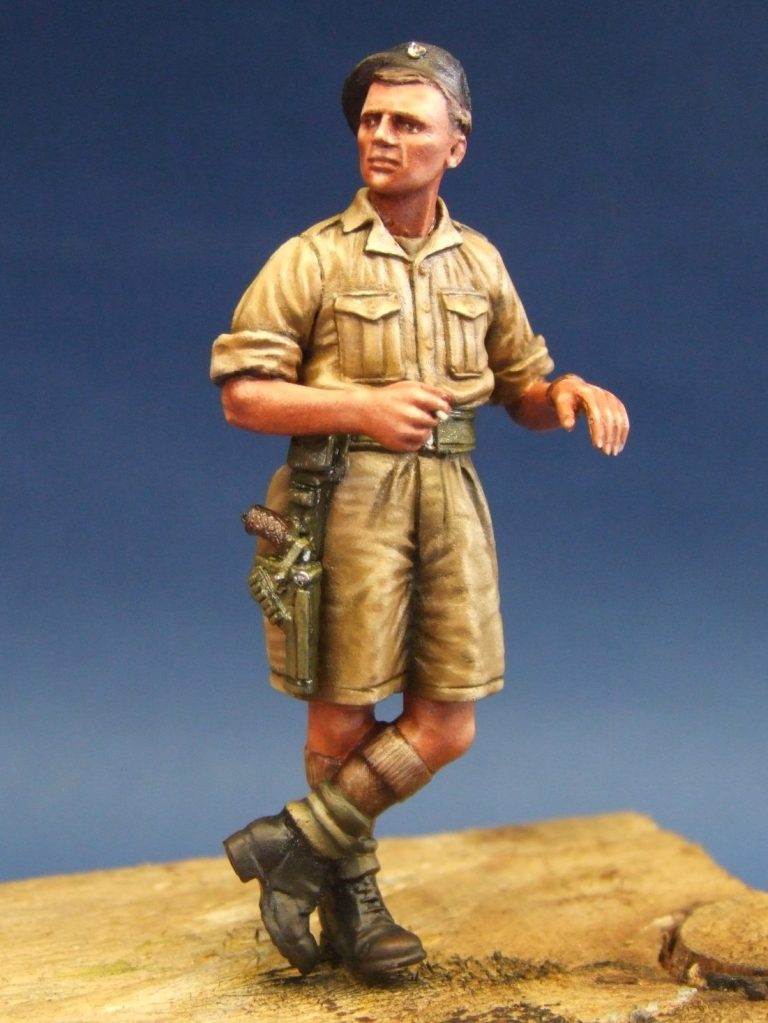





Looking at the finished piece, I’m glad I didn’t do a vehicle. I’m not particularly bad at AFV’s, but it’s a while since I’ve done one, and to be honest, the quality of the figure might be lost with something large and angular dominating the scene. So I like him just how he is.
Frances ( my wife ) agrees. Which is a bleedin’ relief I can tell you !
The final shots show the figure on a small scenic base made from Magic-sculpt, the post is a piece of square section softwood, distressed with the not-so-gentle application of a small hammer. I’ve added a picture background too, of a cliff and a stunted tree growing on it in the last of the pictures; a case of printing of a shot I took on holiday in Spain and propping that up behind the figure whilst the picture was taken.
Summing up.
I’ve several old photos of family members in battle dress, and once thought I’d like to paint models to represent them. As time goes by, it’s harder and harder to find relatives who still have the pertinent information required to research the individual; as documents become lost or are thrown out, and memory in fairness is sometimes not completely reliable.
The problem of finding a model figure is becoming less difficult though, but the question does arise about whether to alter the features to more fully depict the person.
I decided against that, the figure here is tiny, and it’s enough to say he represents Uncle Alf whilst he served out in the desert.
For those who just want a figure to stand next to an AFV, or a simple little project to have a go at, this range of figures are better than a lot of what’s currently on the market. Even better is that there’s a few of them that can be used to represent a tank crew, both loading the vehicle with ammunition, or taking a rest, the mood of the scene being up to the modeller.

We need your consent to load the translations
We use a third-party service to translate the website content that may collect data about your activity. Please review the details in the privacy policy and accept the service to view the translations.